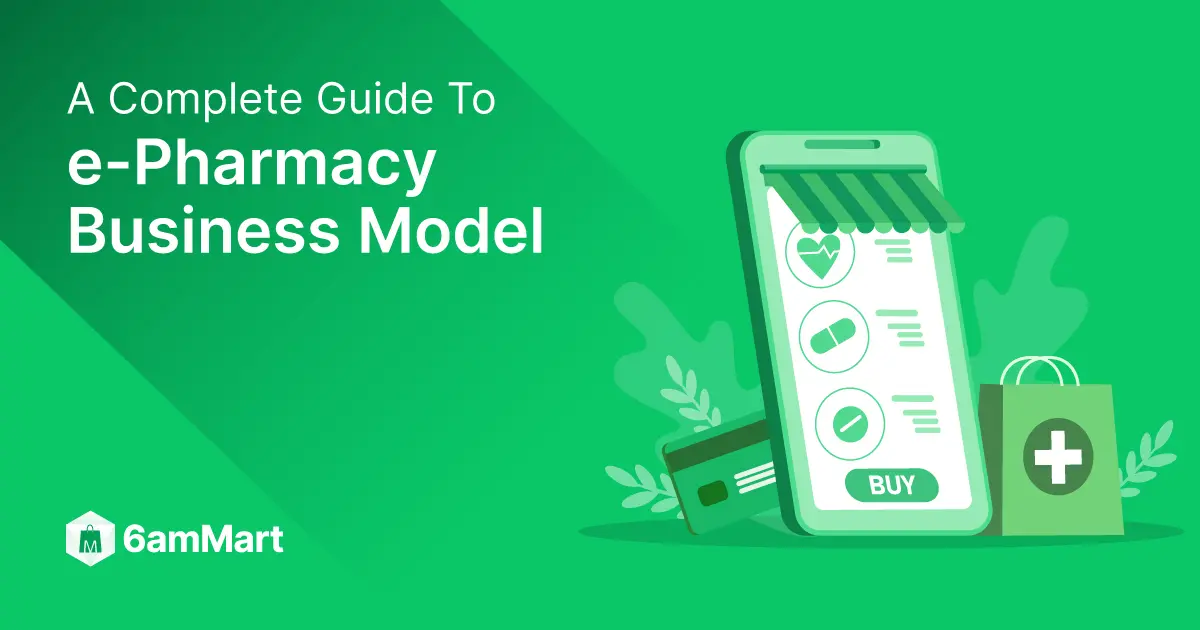Being the youngest of the house, Jay always had to go to the pharmacy for any medical needs of his family. As he was tired of going back & forth after his internship he thought of doing something to solve this issue. Suddenly the idea of starting an online pharmacy came to his mind. But he had no idea how the e-Pharmacy Business Model works!
If you’re like Jay or just someone who needs details of this growing industry and the models working behind this, you just came to the right place.
As the projected market value of e-pharmacy in India is US$649.50m by 2028, the possibilities are huge for businesses. So without any further delay let’s jump to the details.
What is An e-Pharmacy?
An e-pharmacy is an online store for medicine. Instead of going to a physical pharmacy, you easily order your prescribed medicine and medical supplies through the e-pharmacy website or app, and they’re delivered to your door. It’s convenient, fast, and accessible, especially for those with busy schedules or limited mobility.
Different Kinds of e-Pharmacy Business Models
Before diving into being a part of any business, it’s wise to do the groundwork. The same goes for any online pharmacy store. An in-depth knowledge of different business models will help you identify what you want to adopt and run your business with.
There are two main types of e-pharmacy business models. Each of these comes with its own intent, advantages, and drawbacks.

Inventory-Based Model
Simply, it is the online version of traditional brick-and-mortar stores. Here the business owners stock their inventory from different brands into warehouses and sell. There’s no involvement of a third party or middleman in this model.
Inventory-based e-Pharmacy business model definition: An inventory-based business model stores medicines in its inventory and sells directly to customers through an online platform.
How it works: The business or e-pharmacy stocks its inventory in a fulfillment center or warehouse. When a customer places an order, generally, the licensed pharmacy verifies the prescription and starts order processing. Then they pick up the medicine ordered and deliver it securely to customers’ doorsteps.
Advantages:
- Faster delivery: Delivery time is minimized due to the availability of quick dispatch.
- Greater control: This type of e-pharmacy has complete control over product quality, storage conditions, and pricing.
Disadvantages:
- Higher upfront costs: It requires a significant investment in purchasing and storing inventory.
- Limited product selection: The product options may not be as large as other existing models.
- Logistical challenges: The whole model requires efficient storage, manpower, and fulfillment infrastructure.
Marketplace Model
I’m sure you’ve heard online marketplace names like Amazon or eBay or maybe even purchased from those platforms. This model is exactly the same, but it is for pharmacies. Here a digital platform works as a marketplace for customers to buy medicines from different pharmacies in one place.
e-Pharmacy Marketplace business model definition: An e-pharmacy marketplace is an online platform connecting multiple pharmacies with customers to fulfil medication orders.
How it works: This type of e-pharmacy serves as a platform connecting customers with various licensed pharmacies. If a customer orders medicine from a marketplace, it goes directly to the pharmacy’s directory. Then the chosen pharmacy fulfills the order by successful delivery.
Advantages:
- Wider range of pharmacy products: Customers have access to a broader range of medications from different pharmacies.
- Potentially lower costs: Consumers of these platforms get the best prices due to the Competition among pharmacies.
- Lower investment costs: The e-pharmacy doesn’t need to invest in inventory, to reduce upfront costs. Also, if they opt for a readymade platform to launch the business, they can save a lot. If you want to know details about this, keep reading till the end.
Disadvantages:
- Slower delivery: Delivery time may vary depending on the chosen pharmacy’s location, available deliverymen, and overall fulfilment process.
- Less control over quality and pricing: The e-pharmacy platform does not have complete control as it relies on individual pharmacies for product quality and pricing, potentially impacting consistency.
The inventory business model has an extended version of it. This is one of the most popular models to run e-pharmacy stores. Let’s dive into the details below:
Hybrid Model
In the Hybrid e-pharmacy business model, traditional brick-and-mortar pharmacies extend their operations into the digital marketplace. It’s like your neighborhood pharmacy is online now, and they are operating their business both online & offline. This approach combines the physical presence of a local pharmacy with an online platform.
How it works: The traditional store expands its business online by establishing a platform. Customers can browse and purchase medications through the website or app. The store can fulfill the order through home delivery, or the customers can visit the physical store for pickup.
Advantages:
- Convenience: Customers can choose between home delivery and in-store pickup.
- Expand Reach: Pharmacies can reach customers beyond their physical store’s locality.
Disadvantages:
- More complex operations: Requires managing offline and online platforms, increasing operational complexity.
- Competition: May face competition with solely focused digital e-pharmacy businesses.
Now let’s take a look at the industry leaders to see what business models they are using
| e-Pharmacy Name | Business Model |
| Pharmeasy | Marketplace |
| Tata 1 mg | Hybrid |
| Netmeds | Marketplace |
| Medlife | Inventory |
Table: eCommerce business model used by popular Indian e-pharmacies
Read: ePharmacy Market in India
Advantages and Challenges of e-Pharmacy Businesses
As a forward-thinking entrepreneur like Jay, you understand the potential of e-pharmacies to transform the healthcare landscape. Now you have an idea of different e-pharmacy business models, it’s crucial to weigh the advantages and challenges associated with them.
Advantages
Growth potential: The e-pharmacy market is experiencing rapid growth, especially in India, presenting a significant opportunity for businesses to tap into a growing customer base.
Competitive edge: To gain a competitive edge over traditional pharmacies, businesses can offer a convenient ordering system, a wide range of medicine selections, and the best prices in the market.
Operational efficiency: Online medicine delivery platforms of e-pharmacy platforms give the chance to streamline the operational process and optimize inventory ( in an inventory-based model) to reduce operational costs and complexity.
Scalability: Rather than traditional pharmacies, e-pharmacies have the potential to scale their operations more easily. It allows them to reach a wider audience to fulfill a broader range of needs.
Data-driven insights: Online platforms can collect valuable data on customer behavior and preferences. This enables data-driven decision-making and targeted marketing strategies.
Challenges
Adaptation: e-Pharmacies must comply with complex and evolving regulations. This demands constant adaptation and careful compliance measures.
Investment costs: e-Pharmacies need a large upfront investment in technology and inventory, especially the inventory-based model business.
Logistics and fulfillment: Delivery of medication especially the sensitive ones requires an efficient, secure, and temperature-controlled system.
Building trust: Trust is important in the online pharmacy business and can be built through clear communication, transparent pricing, and security measures.
Competition: The e-pharmacy market is highly competitive, and standing out requires a strong value proposition, efficient operations, and customer satisfaction.
Understanding these advantages and challenges allows you to make informed decisions when selecting the right e-pharmacy business model for your business. By carefully considering your target market, resources, and long-term goals, you can navigate the complexities and take action according to that.
Read: Best Online Medicine Delivery Apps in India
How can you start a successful e-pharmacy business?
This step-by-step guide will help you fuel your dream of starting a successful e-pharmacy business.
Market research and planning
First, you will need to identify your target audience by understanding their need, preferences, and online behavior. Also, as there a so many e-pharmacies available, researching their business would help you find the gap in the market and develop a concrete business plan.
Choosing the right e-pharmacy business model
As now you have an idea of the three models of e-pharmacy that I have discussed above, you can now evaluate them for your business considering investment costs, product range, and operational complexity.
Registering your business
Ensure you understand all the legal requirements, including online prescription verification and data privacy.
Building your technological infrastructure
You have two options in this part. Either you can go for custom development or choose a readymade solution. In the custom or manual development process you will have to choose a reliable eCommerce platform to build your e-pharmacy. Then you will have to find a reliable web hosting provider to ensure your website’s performance is up to the mark. You’ll also need development expertise or build a team of developers who can build the website’s functionality lille integration with payment gateways and manage inventory.
If you don’t have enough financial support or resources to go with the manual process there’s a solution for you. You can opt for readymade eCommerce solutions that will help you launch your business without stress. One popular example is 6amMart which offers a complete platform for launching and managing a multi vendor e-pharmacy business.
Marketing and Customer Acquisition
A comprehensive marketing strategy will help you expand your business online and compete head-to-head with the competitors. You can use social media channels, search engine optimization techniques, and targeted advertising for this.
Final Words
Ultimately, the choice of the right e-pharmacy business model depends on various factors, including the target market, desired product range, budget, and operational goals. Before deciding, make sure you know and understand the models in depth to find the perfect fit for your business. We hope this blog helps you gain knowledge about online pharmacy models and how you can be successful in this competitive field.
See you in the next blog!
FAQs
What are the different types of e-pharmacy business models available?
When it comes to e-pharmacy business, there are two main types: the inventory model and the marketplace model. In the inventory model, pharmacies stock and send out medicines ordered online. This can be done entirely online or by combining online and physical stores – also known as a hybrid model. In the marketplace model, platforms connect customers with local pharmacies through apps, making it easy to get medicines from nearby stores.
How can I start a successful e-pharmacy business?
To start a successful e-pharmacy business, research the market, choose your business model, set up your platform – either by building it from scratch or using a ready-made solution, and finally focus on marketing to attract customers.
What challenges do entrepreneurs face when implementing the e-pharmacy business model?
Starting an e-pharmacy business comes with challenges. Keeping up with changing rules, investing in technology and medicines, delivering medications safely, building trust with customers, and facing tough competition are some hurdles that entrepreneurs face.
Meet Mehrin! A technical writer with a Computer Science background. She combines her academic knowledge & creativity to transform complex facts into engaging content. With a sharp eye for detail, she keeps readers updated on tech trends. Outside of writing, she’s a visual storyteller, capturing life’s moments through photography.







